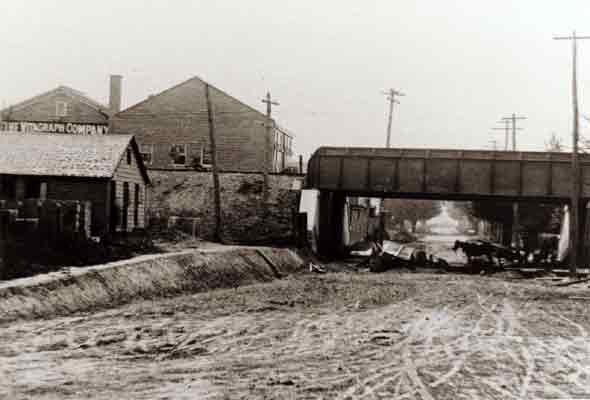
Vitagraph 5 continued from page 4

A
new, unadorned building joins
the original studio.Shot as work
on the Brighton Beach / Manhattan Beach right-of-way neared completion in 1907, the Vitagraph smokestack had
yet to be built. Paul Matus Collection.
Two additional buildings had been completed and two more were abuilding in 1908, moving the studio well along the way to becoming the Vitagraph Village. One important addition was a large water tank, far removed from the tub where the Battle of Manila Bay was fought. It was big enough for a real-life tableau replicating Emmanuel Leutze's famous painting, Washington Crossing the Delaware, in Vitagraph's historical entries on the American icon, Washington Under the British Flag and Washington Under the American Flag, both produced in 1909. Earlier in that year the studio had given equal treatment to Napoleon (Vitagraph, coincidentally, had an office and laboratory in Paris), two one-reelers entitled The Life Drama of Napoleon Bonaparte and the Empress Josephine of France and Napoleon, The Man of Destiny . A poem in honor of these films, and their place of origin, appeared in the New York American :
The great, immortal
Washington
Can nowadays be seen
To cross a local Delaware
With
ice cakes painted green.
Napoleon, too, is pictured
On the field of
Waterloo;
The field looks quite familiar
With its peaceful Flatbush hue.
The Big V ended 1909
with the release of the first of five one-reelers of The Life of
Moses, the high-water mark among its high-art biblical films. High water, indeed,
for in this epic, the Flatbush tank may have reached new heights,
literally as well as figuratively; a stand-in for the Red Sea, after much
trial and error, and with the benefit of double exposure, walls of water
towered over the Israelites in what was advertised as "The Miracle of the
Red Sea / A $10,000 Water Scene." The studio's sense of purpose was
underscored by the man put in charge of the entire production, the
ecumenical reverend Madison C. Peters, whose terms for involving himself
in the project were unequivocal: "I consented to make 'The Life of Moses'
only on the condition that the work be thoroughly done; that those taking
part in the picture reverently approach the subject and that no expense be
spared in the artistic production."
Vitagraph fulfilled its part
of the bargain, especially the last, averaging $10,000 per reel on the
Moses epic at a time when rival Biograph averaged $500 to $600 per reel.
Each installment was released upon completion between about December 4,
1909, and February 19, 1910; after the release of the fifth reel, however,
a number of movie houses showed all five consecutively, making The
Life of Moses, with a running time of about an hour-and-a-half,
the first feature film.
The
most prolific and diverse, and perhaps the most challenging of Vitagraph's
quality films were based on literary works, the greater number of them
classics. 1908 had just dawned when a popular drama, Dion Boucicault's
entertaining play, The Shaughraun, was directed by Blackton, who
played a powerful role in the artistic flowering of the studio. February
brought Francesca da Rimini, a film traced to a more formidable
source: a play of the same name written in 1855 by George H. Boker that
drew its inspiration from Canto V of Dante's Inferno.
©2000 The Composing Stack Inc. All rights
reserved.
urbanography is a service mark of The Composing Stack
Inc.
Updated July 21,
2000.